Psychology Report: Analyzing Coping Mechanisms and Personality Factors
VerifiedAdded on 2020/12/24
|8
|1092
|382
Report
AI Summary
This psychology report provides an analysis of several research papers exploring the relationship between proactive coping, personality traits (specifically the Five-Factor Model), and stress levels in undergraduate students and student teachers. The report examines how proactive coping strategies can mitigate stress, self-blame, and burnout in educational settings. It reviews the methodologies, scopes, usefulness, and limitations of each study, drawing conclusions about the importance of proactive coping as a mediator between stress and self-blame, and highlighting the predictive value of personality traits in coping abilities. The report also discusses the practical implications of these findings for student well-being and the development of effective coping strategies to prevent burnout. The studies included quantitative research methods and involved participants from universities in the UK and the US.
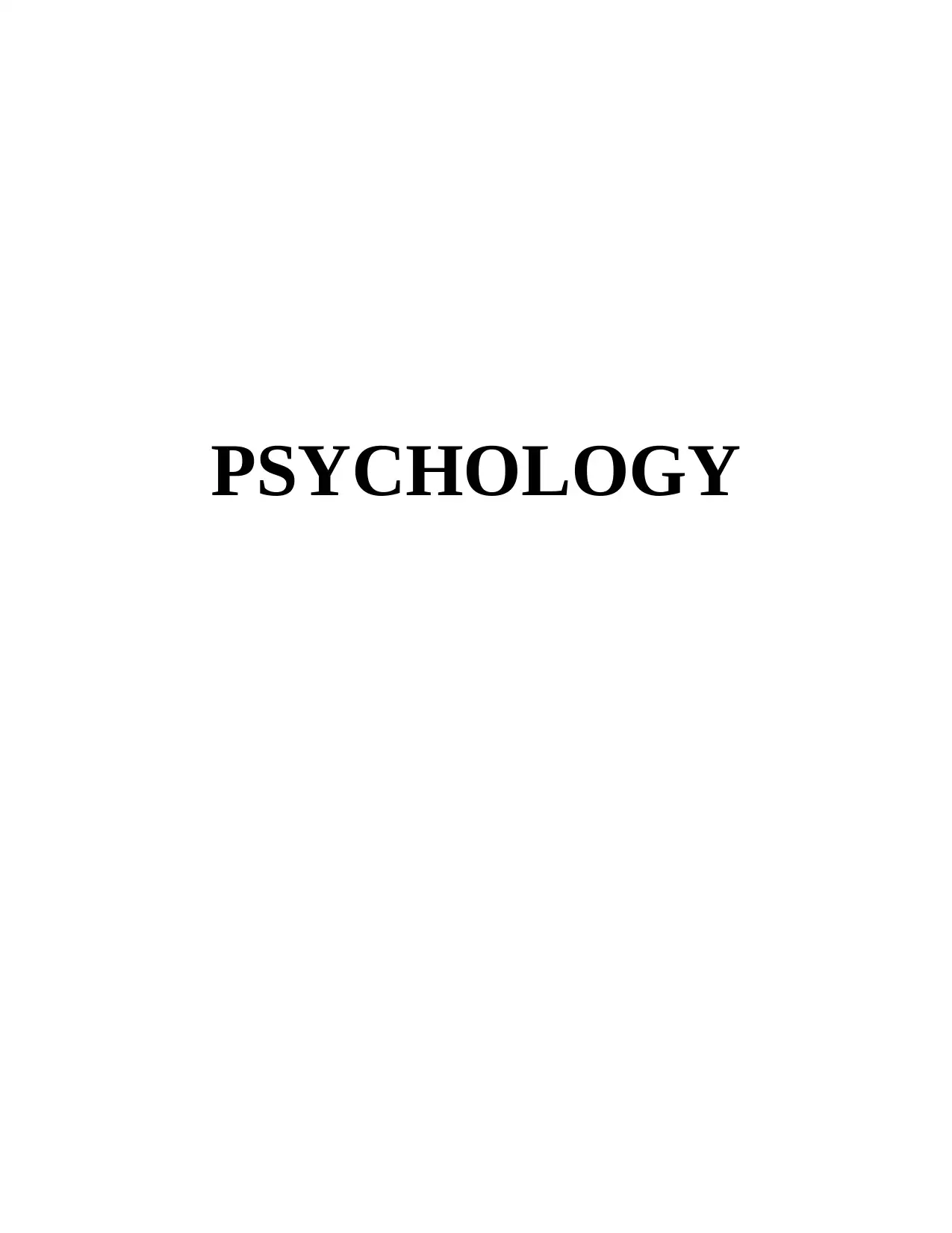
PSYCHOLOGY
Paraphrase This Document
Need a fresh take? Get an instant paraphrase of this document with our AI Paraphraser
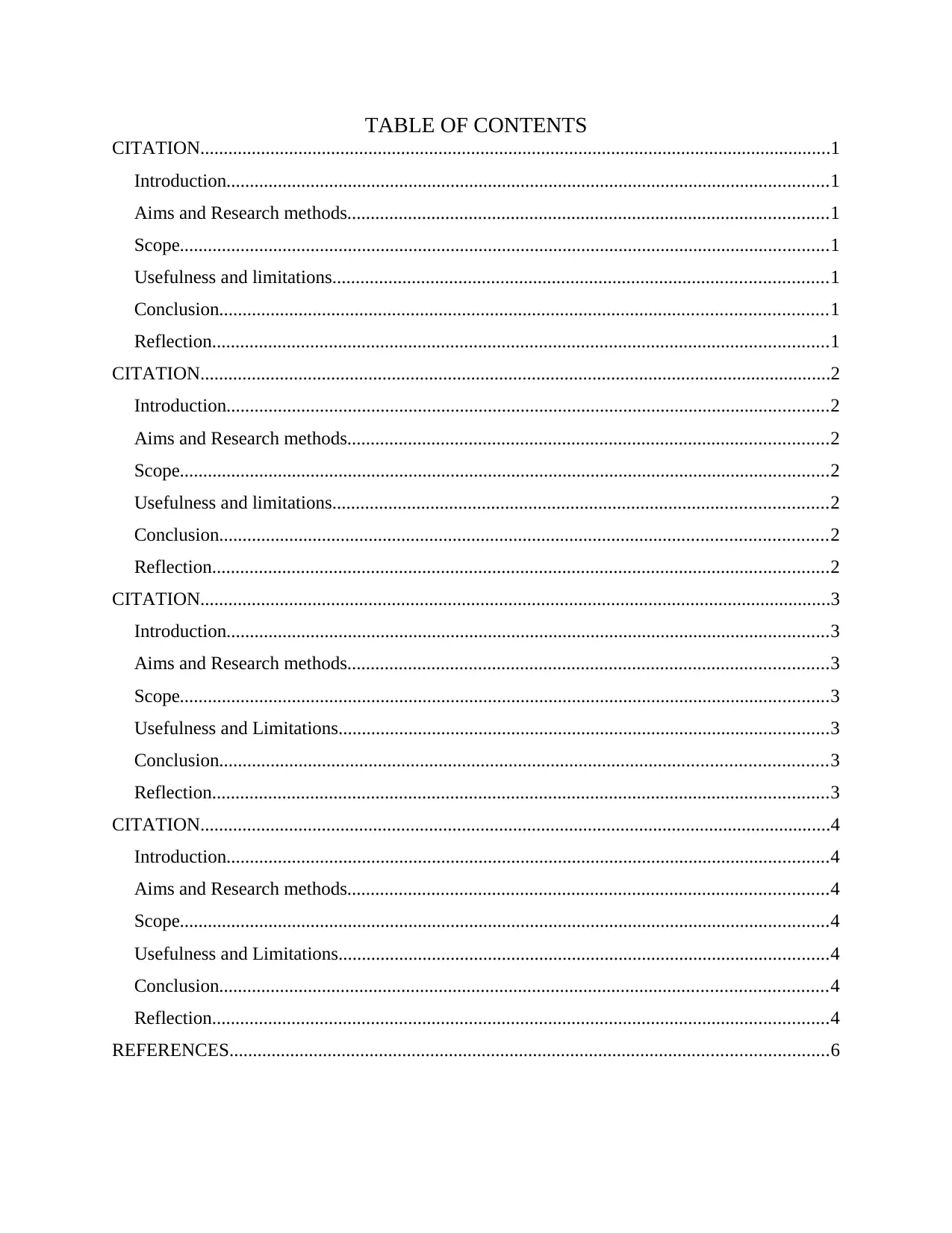
TABLE OF CONTENTS
CITATION.......................................................................................................................................1
Introduction.................................................................................................................................1
Aims and Research methods.......................................................................................................1
Scope...........................................................................................................................................1
Usefulness and limitations..........................................................................................................1
Conclusion..................................................................................................................................1
Reflection....................................................................................................................................1
CITATION.......................................................................................................................................2
Introduction.................................................................................................................................2
Aims and Research methods.......................................................................................................2
Scope...........................................................................................................................................2
Usefulness and limitations..........................................................................................................2
Conclusion..................................................................................................................................2
Reflection....................................................................................................................................2
CITATION.......................................................................................................................................3
Introduction.................................................................................................................................3
Aims and Research methods.......................................................................................................3
Scope...........................................................................................................................................3
Usefulness and Limitations.........................................................................................................3
Conclusion..................................................................................................................................3
Reflection....................................................................................................................................3
CITATION.......................................................................................................................................4
Introduction.................................................................................................................................4
Aims and Research methods.......................................................................................................4
Scope...........................................................................................................................................4
Usefulness and Limitations.........................................................................................................4
Conclusion..................................................................................................................................4
Reflection....................................................................................................................................4
REFERENCES................................................................................................................................6
CITATION.......................................................................................................................................1
Introduction.................................................................................................................................1
Aims and Research methods.......................................................................................................1
Scope...........................................................................................................................................1
Usefulness and limitations..........................................................................................................1
Conclusion..................................................................................................................................1
Reflection....................................................................................................................................1
CITATION.......................................................................................................................................2
Introduction.................................................................................................................................2
Aims and Research methods.......................................................................................................2
Scope...........................................................................................................................................2
Usefulness and limitations..........................................................................................................2
Conclusion..................................................................................................................................2
Reflection....................................................................................................................................2
CITATION.......................................................................................................................................3
Introduction.................................................................................................................................3
Aims and Research methods.......................................................................................................3
Scope...........................................................................................................................................3
Usefulness and Limitations.........................................................................................................3
Conclusion..................................................................................................................................3
Reflection....................................................................................................................................3
CITATION.......................................................................................................................................4
Introduction.................................................................................................................................4
Aims and Research methods.......................................................................................................4
Scope...........................................................................................................................................4
Usefulness and Limitations.........................................................................................................4
Conclusion..................................................................................................................................4
Reflection....................................................................................................................................4
REFERENCES................................................................................................................................6
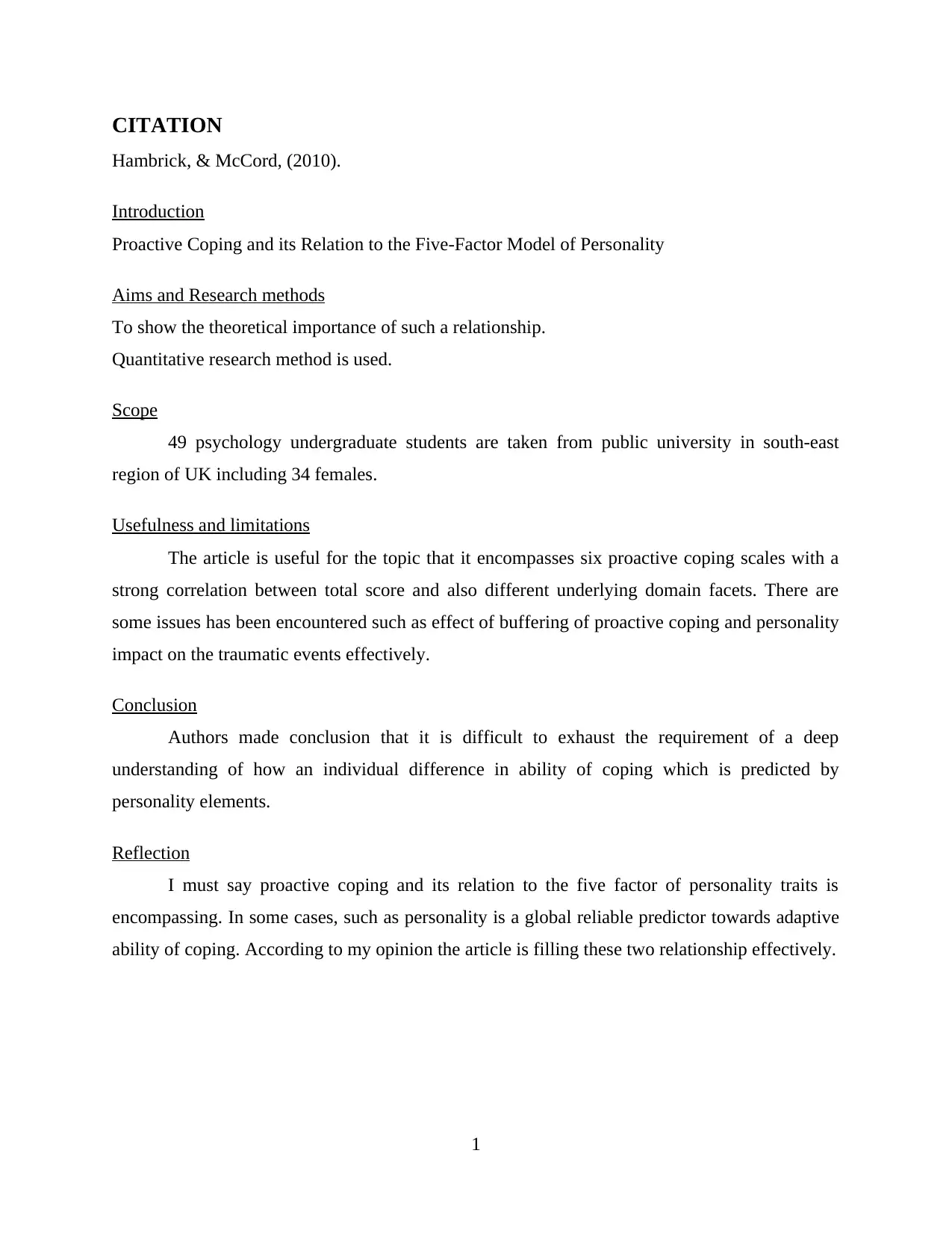
CITATION
Hambrick, & McCord, (2010).
Introduction
Proactive Coping and its Relation to the Five-Factor Model of Personality
Aims and Research methods
To show the theoretical importance of such a relationship.
Quantitative research method is used.
Scope
49 psychology undergraduate students are taken from public university in south-east
region of UK including 34 females.
Usefulness and limitations
The article is useful for the topic that it encompasses six proactive coping scales with a
strong correlation between total score and also different underlying domain facets. There are
some issues has been encountered such as effect of buffering of proactive coping and personality
impact on the traumatic events effectively.
Conclusion
Authors made conclusion that it is difficult to exhaust the requirement of a deep
understanding of how an individual difference in ability of coping which is predicted by
personality elements.
Reflection
I must say proactive coping and its relation to the five factor of personality traits is
encompassing. In some cases, such as personality is a global reliable predictor towards adaptive
ability of coping. According to my opinion the article is filling these two relationship effectively.
1
Hambrick, & McCord, (2010).
Introduction
Proactive Coping and its Relation to the Five-Factor Model of Personality
Aims and Research methods
To show the theoretical importance of such a relationship.
Quantitative research method is used.
Scope
49 psychology undergraduate students are taken from public university in south-east
region of UK including 34 females.
Usefulness and limitations
The article is useful for the topic that it encompasses six proactive coping scales with a
strong correlation between total score and also different underlying domain facets. There are
some issues has been encountered such as effect of buffering of proactive coping and personality
impact on the traumatic events effectively.
Conclusion
Authors made conclusion that it is difficult to exhaust the requirement of a deep
understanding of how an individual difference in ability of coping which is predicted by
personality elements.
Reflection
I must say proactive coping and its relation to the five factor of personality traits is
encompassing. In some cases, such as personality is a global reliable predictor towards adaptive
ability of coping. According to my opinion the article is filling these two relationship effectively.
1
⊘ This is a preview!⊘
Do you want full access?
Subscribe today to unlock all pages.

Trusted by 1+ million students worldwide
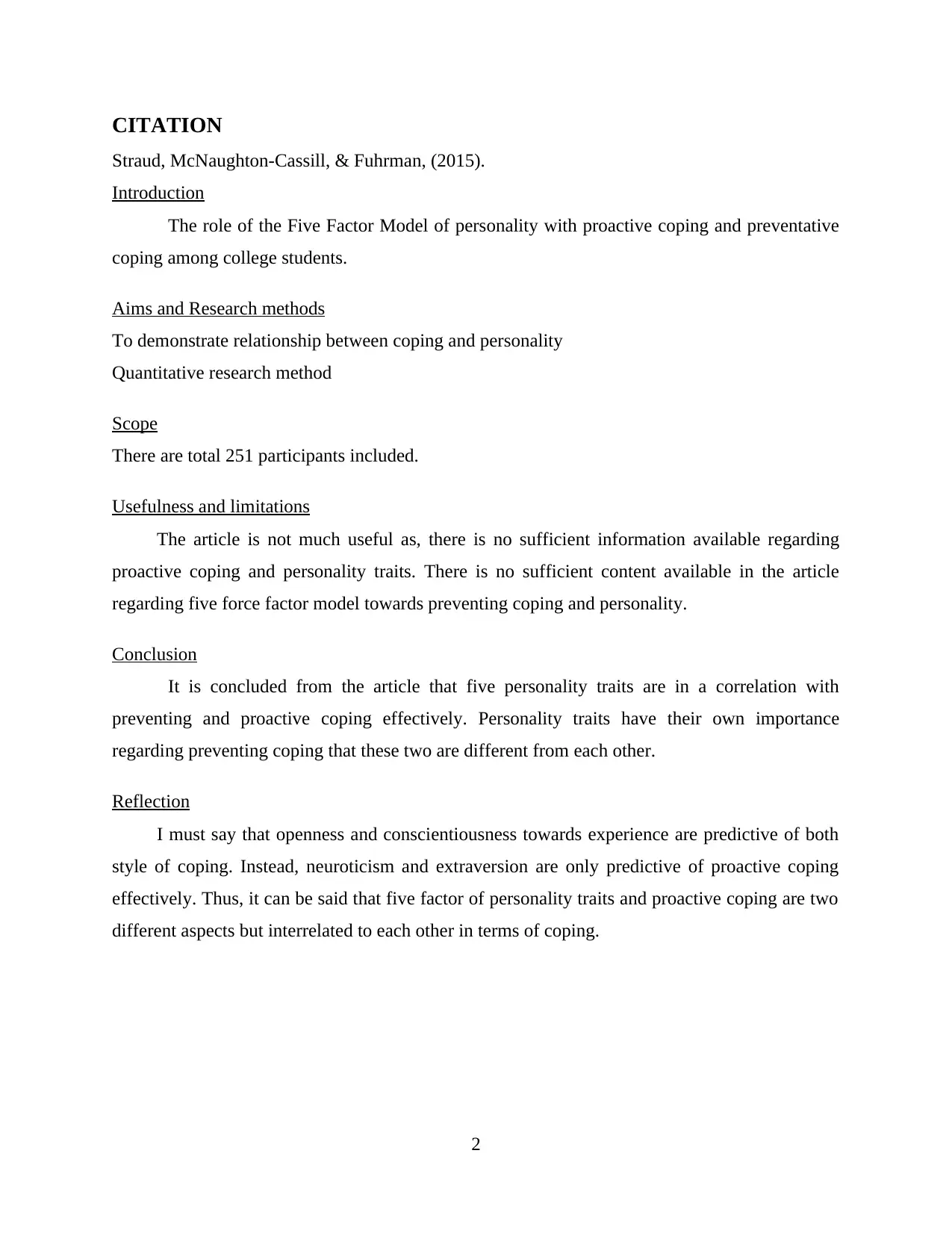
CITATION
Straud, McNaughton-Cassill, & Fuhrman, (2015).
Introduction
The role of the Five Factor Model of personality with proactive coping and preventative
coping among college students.
Aims and Research methods
To demonstrate relationship between coping and personality
Quantitative research method
Scope
There are total 251 participants included.
Usefulness and limitations
The article is not much useful as, there is no sufficient information available regarding
proactive coping and personality traits. There is no sufficient content available in the article
regarding five force factor model towards preventing coping and personality.
Conclusion
It is concluded from the article that five personality traits are in a correlation with
preventing and proactive coping effectively. Personality traits have their own importance
regarding preventing coping that these two are different from each other.
Reflection
I must say that openness and conscientiousness towards experience are predictive of both
style of coping. Instead, neuroticism and extraversion are only predictive of proactive coping
effectively. Thus, it can be said that five factor of personality traits and proactive coping are two
different aspects but interrelated to each other in terms of coping.
2
Straud, McNaughton-Cassill, & Fuhrman, (2015).
Introduction
The role of the Five Factor Model of personality with proactive coping and preventative
coping among college students.
Aims and Research methods
To demonstrate relationship between coping and personality
Quantitative research method
Scope
There are total 251 participants included.
Usefulness and limitations
The article is not much useful as, there is no sufficient information available regarding
proactive coping and personality traits. There is no sufficient content available in the article
regarding five force factor model towards preventing coping and personality.
Conclusion
It is concluded from the article that five personality traits are in a correlation with
preventing and proactive coping effectively. Personality traits have their own importance
regarding preventing coping that these two are different from each other.
Reflection
I must say that openness and conscientiousness towards experience are predictive of both
style of coping. Instead, neuroticism and extraversion are only predictive of proactive coping
effectively. Thus, it can be said that five factor of personality traits and proactive coping are two
different aspects but interrelated to each other in terms of coping.
2
Paraphrase This Document
Need a fresh take? Get an instant paraphrase of this document with our AI Paraphraser
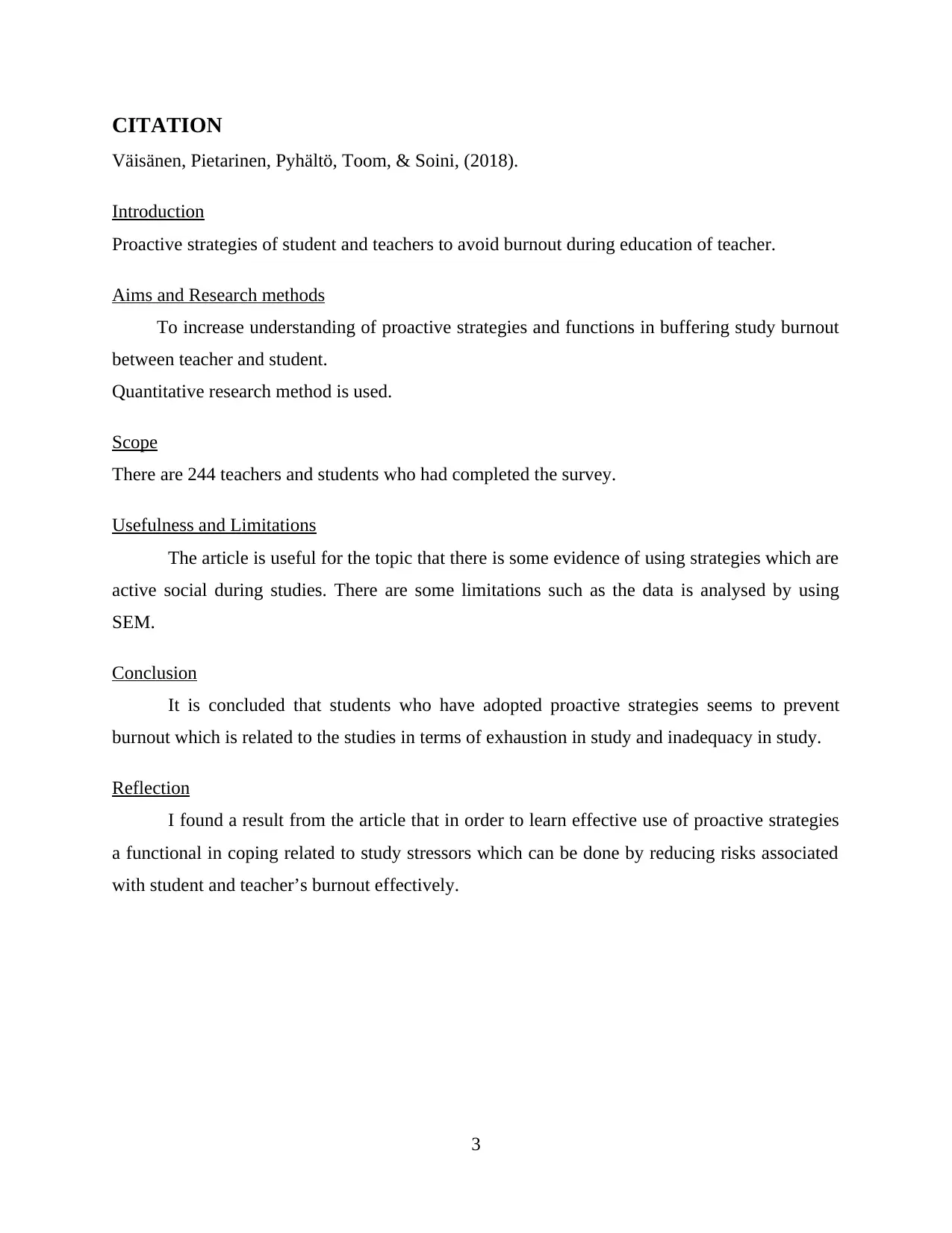
CITATION
Väisänen, Pietarinen, Pyhältö, Toom, & Soini, (2018).
Introduction
Proactive strategies of student and teachers to avoid burnout during education of teacher.
Aims and Research methods
To increase understanding of proactive strategies and functions in buffering study burnout
between teacher and student.
Quantitative research method is used.
Scope
There are 244 teachers and students who had completed the survey.
Usefulness and Limitations
The article is useful for the topic that there is some evidence of using strategies which are
active social during studies. There are some limitations such as the data is analysed by using
SEM.
Conclusion
It is concluded that students who have adopted proactive strategies seems to prevent
burnout which is related to the studies in terms of exhaustion in study and inadequacy in study.
Reflection
I found a result from the article that in order to learn effective use of proactive strategies
a functional in coping related to study stressors which can be done by reducing risks associated
with student and teacher’s burnout effectively.
3
Väisänen, Pietarinen, Pyhältö, Toom, & Soini, (2018).
Introduction
Proactive strategies of student and teachers to avoid burnout during education of teacher.
Aims and Research methods
To increase understanding of proactive strategies and functions in buffering study burnout
between teacher and student.
Quantitative research method is used.
Scope
There are 244 teachers and students who had completed the survey.
Usefulness and Limitations
The article is useful for the topic that there is some evidence of using strategies which are
active social during studies. There are some limitations such as the data is analysed by using
SEM.
Conclusion
It is concluded that students who have adopted proactive strategies seems to prevent
burnout which is related to the studies in terms of exhaustion in study and inadequacy in study.
Reflection
I found a result from the article that in order to learn effective use of proactive strategies
a functional in coping related to study stressors which can be done by reducing risks associated
with student and teacher’s burnout effectively.
3
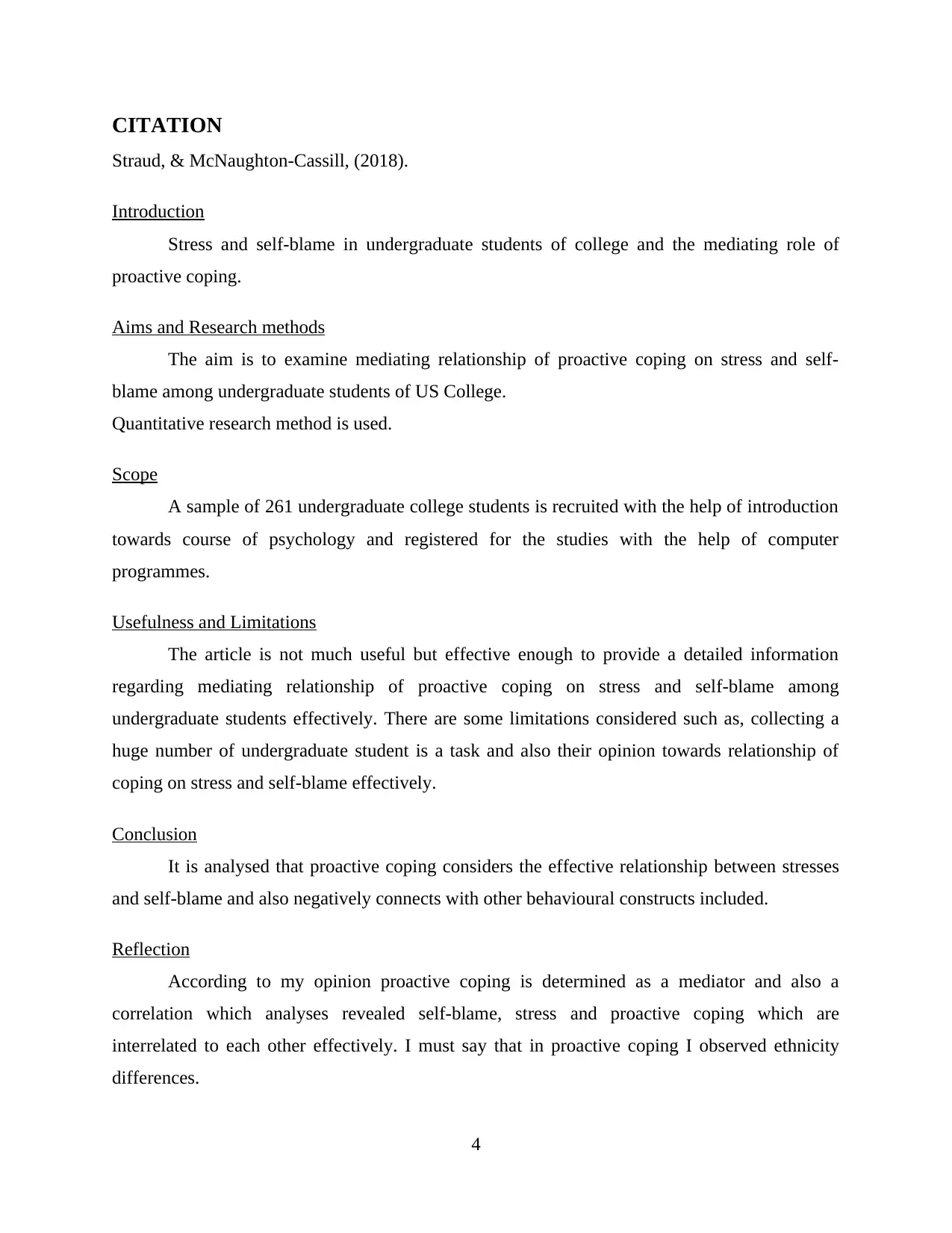
CITATION
Straud, & McNaughton-Cassill, (2018).
Introduction
Stress and self-blame in undergraduate students of college and the mediating role of
proactive coping.
Aims and Research methods
The aim is to examine mediating relationship of proactive coping on stress and self-
blame among undergraduate students of US College.
Quantitative research method is used.
Scope
A sample of 261 undergraduate college students is recruited with the help of introduction
towards course of psychology and registered for the studies with the help of computer
programmes.
Usefulness and Limitations
The article is not much useful but effective enough to provide a detailed information
regarding mediating relationship of proactive coping on stress and self-blame among
undergraduate students effectively. There are some limitations considered such as, collecting a
huge number of undergraduate student is a task and also their opinion towards relationship of
coping on stress and self-blame effectively.
Conclusion
It is analysed that proactive coping considers the effective relationship between stresses
and self-blame and also negatively connects with other behavioural constructs included.
Reflection
According to my opinion proactive coping is determined as a mediator and also a
correlation which analyses revealed self-blame, stress and proactive coping which are
interrelated to each other effectively. I must say that in proactive coping I observed ethnicity
differences.
4
Straud, & McNaughton-Cassill, (2018).
Introduction
Stress and self-blame in undergraduate students of college and the mediating role of
proactive coping.
Aims and Research methods
The aim is to examine mediating relationship of proactive coping on stress and self-
blame among undergraduate students of US College.
Quantitative research method is used.
Scope
A sample of 261 undergraduate college students is recruited with the help of introduction
towards course of psychology and registered for the studies with the help of computer
programmes.
Usefulness and Limitations
The article is not much useful but effective enough to provide a detailed information
regarding mediating relationship of proactive coping on stress and self-blame among
undergraduate students effectively. There are some limitations considered such as, collecting a
huge number of undergraduate student is a task and also their opinion towards relationship of
coping on stress and self-blame effectively.
Conclusion
It is analysed that proactive coping considers the effective relationship between stresses
and self-blame and also negatively connects with other behavioural constructs included.
Reflection
According to my opinion proactive coping is determined as a mediator and also a
correlation which analyses revealed self-blame, stress and proactive coping which are
interrelated to each other effectively. I must say that in proactive coping I observed ethnicity
differences.
4
⊘ This is a preview!⊘
Do you want full access?
Subscribe today to unlock all pages.

Trusted by 1+ million students worldwide

5
Paraphrase This Document
Need a fresh take? Get an instant paraphrase of this document with our AI Paraphraser
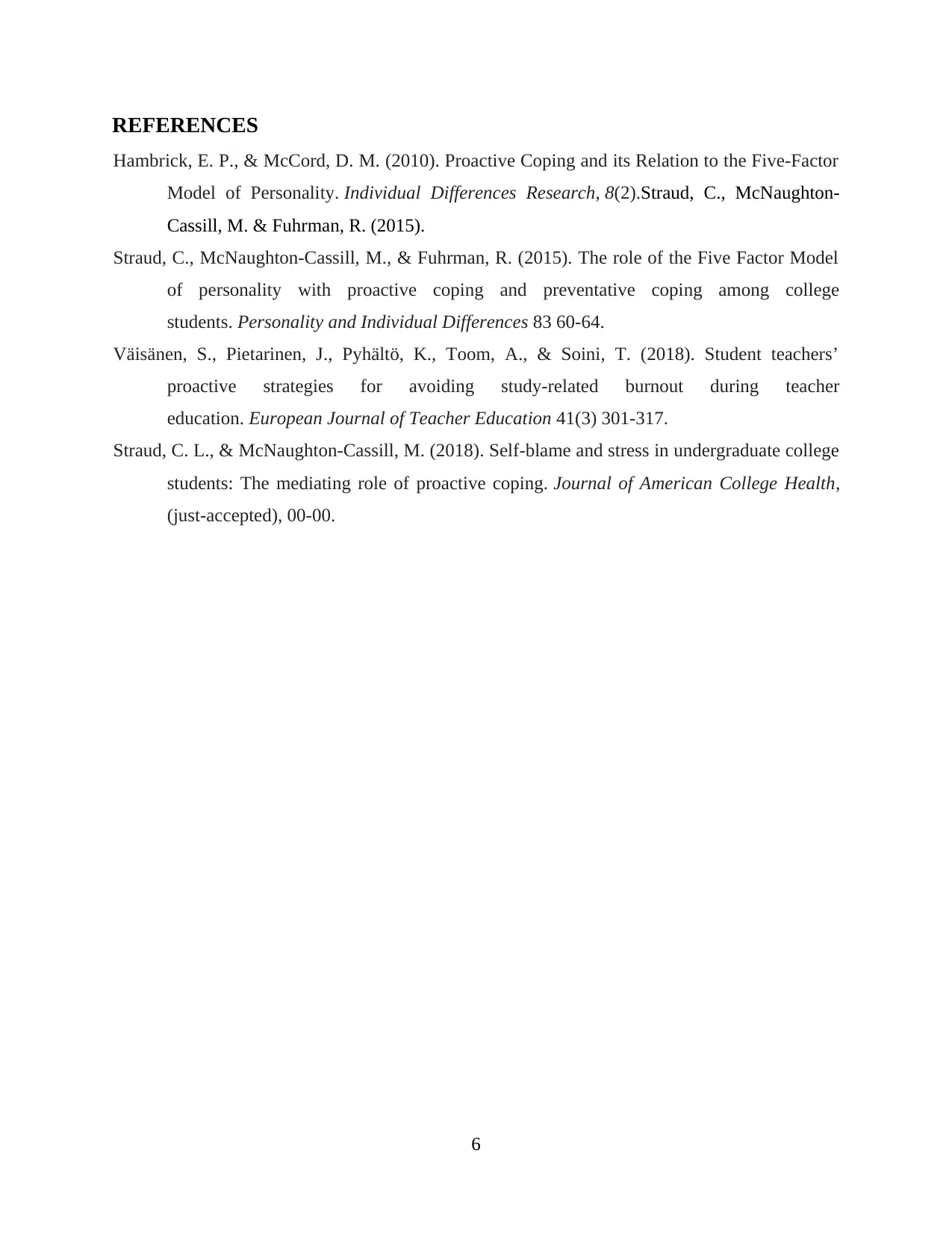
REFERENCES
Hambrick, E. P., & McCord, D. M. (2010). Proactive Coping and its Relation to the Five-Factor
Model of Personality. Individual Differences Research, 8(2).Straud, C., McNaughton-
Cassill, M. & Fuhrman, R. (2015).
Straud, C., McNaughton-Cassill, M., & Fuhrman, R. (2015). The role of the Five Factor Model
of personality with proactive coping and preventative coping among college
students. Personality and Individual Differences 83 60-64.
Väisänen, S., Pietarinen, J., Pyhältö, K., Toom, A., & Soini, T. (2018). Student teachers’
proactive strategies for avoiding study-related burnout during teacher
education. European Journal of Teacher Education 41(3) 301-317.
Straud, C. L., & McNaughton-Cassill, M. (2018). Self-blame and stress in undergraduate college
students: The mediating role of proactive coping. Journal of American College Health,
(just-accepted), 00-00.
6
Hambrick, E. P., & McCord, D. M. (2010). Proactive Coping and its Relation to the Five-Factor
Model of Personality. Individual Differences Research, 8(2).Straud, C., McNaughton-
Cassill, M. & Fuhrman, R. (2015).
Straud, C., McNaughton-Cassill, M., & Fuhrman, R. (2015). The role of the Five Factor Model
of personality with proactive coping and preventative coping among college
students. Personality and Individual Differences 83 60-64.
Väisänen, S., Pietarinen, J., Pyhältö, K., Toom, A., & Soini, T. (2018). Student teachers’
proactive strategies for avoiding study-related burnout during teacher
education. European Journal of Teacher Education 41(3) 301-317.
Straud, C. L., & McNaughton-Cassill, M. (2018). Self-blame and stress in undergraduate college
students: The mediating role of proactive coping. Journal of American College Health,
(just-accepted), 00-00.
6
1 out of 8
Related Documents
Your All-in-One AI-Powered Toolkit for Academic Success.
+13062052269
info@desklib.com
Available 24*7 on WhatsApp / Email
![[object Object]](/_next/static/media/star-bottom.7253800d.svg)
Unlock your academic potential
Copyright © 2020–2025 A2Z Services. All Rights Reserved. Developed and managed by ZUCOL.





